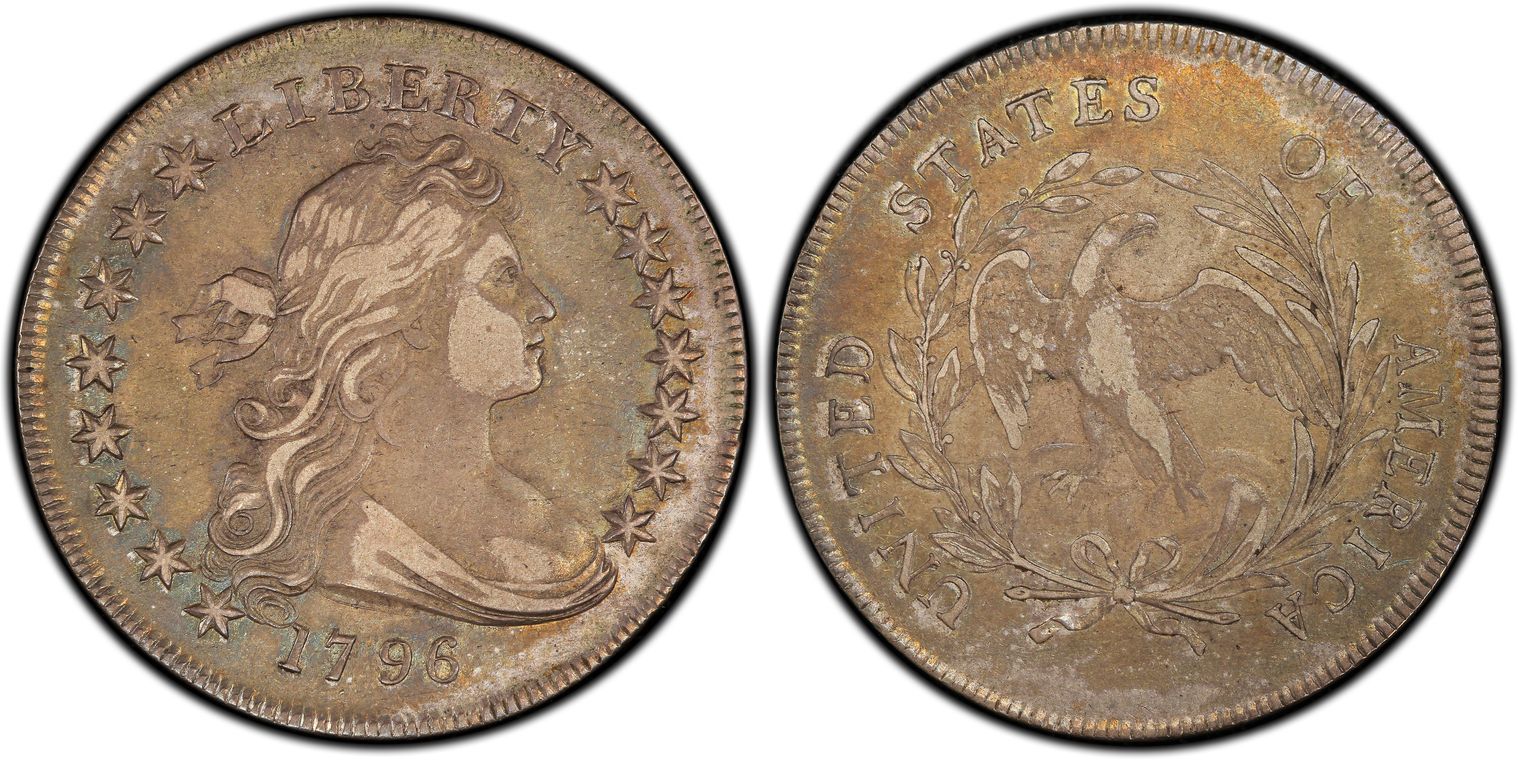1796 $1 BB-66, Small Date & Letters XF45 认证号27942465, PCGS号39999
专家评论
Q. David Bowers
The following narrative, with minor editing, is from my "Silver Dollars & Trade Dollars of the United States: A Complete Encyclopedia" (Wolfeboro, NH: Bowers and Merena Galleries, Inc., 1993). Note: the Notable Specimens list should be used with caution - it has been updated in my 2013 edition of "The Encyclopedia of United States Silver Dollars 1794-1804."B-1. H-1.
OBVERSE 4: Small date; the 9 and 6 closer together than other figures. Highest wave of hair under upright of E; second highest wave under and slightly to the right of the middle of R. End of hair tress touches innermost point of star 1 on its right, and continues slightly past it. The curly lock closest to the date barely touches the star point to the right of the innermost point of star 1 (magnification may be necessary to tell this; on BB-63 the curly lock clearly misses this star point). On BB-66, star 1 points at a denticle (on BB-63 it points to the space between two denticles). A point of star 15 points to a spot high on the drapery folds (on BB-63, it points to the middle of the drapery folds).
This obverse bears a close resemblance with that of BB-63, and specimens should be compared to it. This and the obverse die used to strike BB-61 and BB-62 were the first two obverse dies cut in 1796, and have the lower right tip of the R in LIBERTY intact.
Obverse die used to strike 1796 BB-66 only. I believe this obverse, although it was one of the first obverses made in 1796, was first used for coinage in calendar year 1798.
REVERSE B: Described under 1795 BB-51, herewith repeated: Small Eagle. Small Letters in legend. Eagle stands on clouds. Wreath is composed of a palm branch (right) and olive branch (left), the latter with seven berries. A short, prominent die scratch extends up to left from tip of right, inside leaf below (observer's) left wing. Berry under A of STATES; a quick way to identify this reverse.
Reverse die used to strike 1795 BB-51; 1796 BB-62, BB-63, and BB-66 (now relapped); 1797 BB-72; and 1798 BB-81.
DIE STATES:
Die State I: Perfect dies. Reverse die state the same as used on 1795 BB-51; no lapping yet (compare to die states of 1796 BB-63). May not exist with 1796 BB-66.
Die State II: Reverse die relapped, removing some details of the shallowest (lowest) folds in the wreath ribbon and removing about 50% of the lowest left leaf on the wreath (just below the U of UNITED). In the process, the border denticles were made smaller, and the rim, low to begin with, was nearly reduced to insignificance. This die state was also used to coin 1797 BB-72 and 1798 BB-82. As there was no longer much in the way of a protective rim on the reverse, this side of the coin wore away quickly in circulation. This is the only die state of 1796 BB-66 seen by the author. Thus, 1796 BB-66 was coined after 1796 BB-62 and BB-63. I consider it to be a strong possibility that 1796 BB-66 was coined in 1798, at or near the same time 1797 BB-72 and 1798 BB-81 were struck.
COLLECTING NOTES: I estimate that 1796 BB-66 exists to the extent of 200 to 350 pieces, most of which are in grades from well worn to VF, with a very occasional EF and an even more infrequent AU. No Mint State coins have been reported. The builders of other great collections were fortunate if they had a VF coin. Bolender's personal coin was VF, ex Primus C. Clark, 1932.
The typical 1796 BB-66 silver dollar is well centered and, if high grade, has excellent striking detail at the center of both sides. On worn specimens, the reverse details are typically less well defined than the obverse, as the reverse, lacking a satisfactory protective rim, wore away quickly. For this reason, grading of the variety is by the obverse only.
Another mystery involving early dollars is that surrounding the distribution pattern of 1796 BB-66. Why are most in lower grades as compared to, for example, 1795 BB-51?
NOTABLE SPECIMENS:
Newman Specimen. MS-60/62. Eric Newman Collection.
Surfaces with pale gold, brown, and blue patina. Die State II.
Davis Specimen. AU-50. R. Coulton Davis. W.G . Baldenhofer; Stack's Farish-Baldenhofer Sale: 432. AJ. Ostheimer,3rd. Gilhousen Collection, Superior, 1973: 122l. "Practically Uncirculated, deeply toned but with much mint lustre, light cabinet friction in very center of reverse, many central obverse adjustment marks." Superior, 1975: 82l.
Higgins Specimen. EF-40. • Bowers and Merena, Lloyd M. Higgins, M.D. Collection, 1988:2209. Spectacular iridescent blue toning wreaths the obverse periphery, while its center is a bright golden brown. Even gray toning on the reverse, with undertones of pale gold.
Herdegen Specimen. Net VF-20 (EF-40, scratched) .. Schulman, Herdegen Collection, 1973. EF, two scratches near wing, initials "H F" scratched on reverse below wreath. Toned.
Turoff Specimen. Net VF-20 (EF-40, retooled).• Bowers and Ruddy, Julius Turoff Collection, 1976: 1079. "EF and apparently well struck, but actually reinforced by some skillful retooling on Liberty's face. Excellent rims, edges and surfaces, graced by a light gray toning."
PCGS #
39999
设计师
Robert Scot/John Eckstein
边缘
Lettered: HUNDRED CENTS ONE DOLLAR OR UNIT
直径
40.00 毫米
重量
27.00 克
铸币数量
79920
金属成分
90% Silver, 10% Copper
更高评级数量
1
评级较低的钱币数量
9
地区
The United States of America
价格指南
PCGS 数量报告
拍卖 - PCGS 评级的
拍卖 - NGC 评级的























